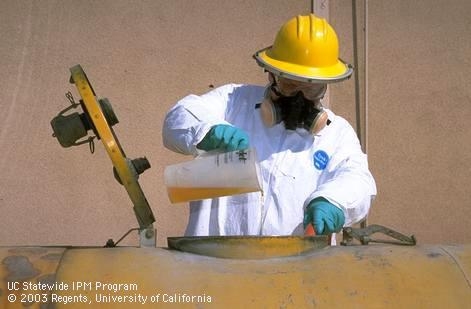If you can’t speak the language, you can’t follow the conversation. Talk about adjuvants used in agriculture can be filled with unfamiliar terms like activator, non-ionic surfactant, penetrant, humectants, and buffers. To help growers who want follow a sales pitch or discussion on adjuvants, the following article lists and describes common adjuvant categories by function. This is the first of a series to help growers better understand adjuvants and their effective use.
There are two types of adjuvants – spray adjuvants and formulation adjuvants. Spray adjuvants are packaged separate from pesticides. Formulation adjuvants are mixed with the pesticide active ingredient during packaging and formulation. This article is concerned specifically with spray adjuvants.
Spray adjuvants are pesticides according to California Department of Pesticide Regulation (CDPR). They must be registered. Spray adjuvants are defined by CDPR as “a product solid in a separate package and intended to be used with another pesticide to aid the application or enhance the activity of the pesticide.” Growers must report spray adjuvant use in their monthly pesticide use reports.
There are two general categories of spray adjuvants: 1) activator adjuvants and 2) utility adjuvants. Activator adjuvants directly enhance pesticide performance once the spray hits the plant target. They include wetter-spreaders, stickers, penetrants, and humectants. Utility adjuvants help make the spray application process go better. This group includes defoamers, drift control agents, deposition aides, water conditioners, acidifiers, buffers, and colorants. A single adjuvant product can be both an activator and a utility adjuvant. For example, a product that contains a spreader/penetrant plus a buffer/acidifier is both an activator and utility adjuvant.
There are several categories based on product function within the general groups of activator and utility adjuvants. Many adjuvants fit into multiple categories, as a particular set of ingredients may provide spreading and penetrating properties to a single packaged product.
Wetter-Spreaders: contains surface-active ingredients – surfactants -- that reduce the contact angle of the spray droplet on the target (see Figure 1.). This allows the spray solution to contact more of the target surface. Spreading is essentially an extension of the wetting process. A spreader adjuvant allows the spray droplet to spread over a larger area of the target compared to a droplet with no spreader.
Most pesticides are mixed with water and sprayed. Wetter-spreaders behave differently in your spray tank based on their electrical charge in water. Surfactants –the active ingredients in wetter-spreader adjuvant -- are further categorized as non-ionic, cationic, anionic, or amphoteric surfactants. Why is this important to a grower? When choosing an adjuvant to use with a water soluble ionic herbicide, you don’t want an adjuvant “tying up” your pesticide and reducing pest control. For example, when mixed in the spray tank, a cationic spreader may bind to an anionic herbicide, possibly reducing the pesticide activity. If you use an adjuvant, make sure it matches the pesticide label adjuvant recommendation.
Wetter-spreaders are surface active because they contain surfactant molecules that have a fat/wax loving (lipophilic) end and a water loving (hydrophilic) end. Common ingredients include fatty amines, glucosides, alkyphols, alkylamine ethoxylates, polyethylene oxides, and organosilicones.
Stickers: contains non-evaporating ingredients that resist dislodging of the spray deposit from the target surface. Common sticker ingredients include synthetic latex, low volatile oils, pinene polymer, water-soluble polymers, and resins. The less water soluble the ingredients the lower the “wash off” potential of the pesticide deposit.
Humectants: contains ingredients that reduce spray droplet evaporation before and after it reaches the
target. Humectant materials include glycerin, various glycols, petroleum oils, vegetable oils, and urea.
Penetrators: contain ingredients that help the chemical enter the target plant once the spray is deposited. Petroleum oils, vegetable oils, or modified vegetable oils are common penetrator ingredients.
Compatibility Agents: commonly used to keep a homogeneous solution in a spray tank that contains multiple ingredients, usually including liquid fertilizer.
Defoamers: eliminate or suppress foam in the spray tank.
Drift Control Agent: used to reduce the percentage of spray droplets below a certain diameter in an application. Small droplets are considered “driftable fines”. The smaller the droplet, the farther it will move with wind. Droplets with a diameter less than 150 mm are frequently characterized as “driftable”. Drift control agent commonly include polyacrylamides and polysaccharides.
Deposition agent: do not change spray droplet size, but improve the amount of pesticide deposited on the target – indirectly reducing drift -- or improve the uniformity of spray deposits.
Water Conditioner: eliminates or reduces the interaction of ions in the spray solution with the pesticide. For example, glyphosate efficacy can be reduced when hard water is used in the spray tank. A range of materials including chelating agents, citric acids, and fertilizer salts such as ammonium sulfate and ammonium nitrate are used as water conditioners to improve glyphosate activity when the spray water source contains hard water.
Acidifier: usually a dilute strong acid solution used to reduce spray water pH. An acidifier will commonly not maintain – that is, buffer – the spray solution at a certain desired pH range. Addition of an alkaline pesticide or fertilizer will increase the spray solution pH that was initially lowered by an acidifier.
Buffer: a product that will resist change in the spray solution pH. Buffers will limit the change in solution pH when an acid or base are added to the tank. A buffer/acidifier will reduce spray water pH AND hold the pH in a certain range. How long the pH is held in a certain range when other pesticides or fertilizers are added differs between products. The correct rate of buffer depends on the water source and materials in the tank. Commonly used buffers are buffer/acidifiers using ingredients such as phosphates or organic acids.
Colorants: alters the color of the spray solution so that previous spray passes are visible to the applicator.
So, there’s the general “line up” of adjuvant materials. Once you know the players and their roles in the spray tank, you can begin to select the right material for the job.
